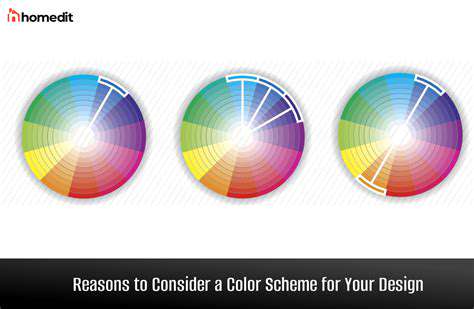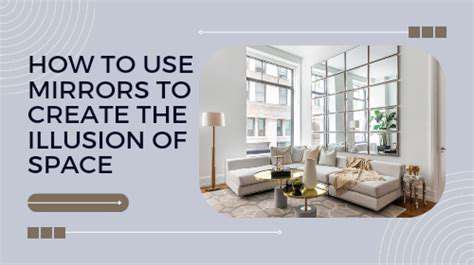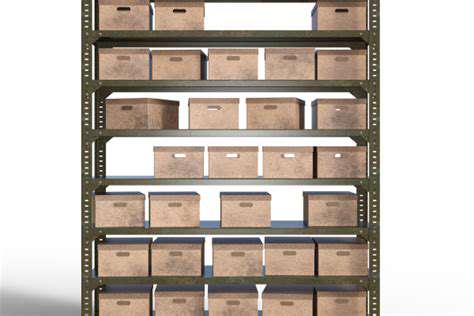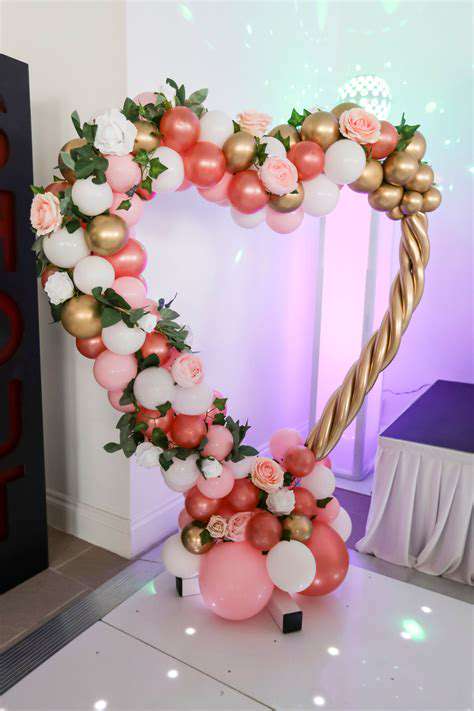How to Choose a Modern Color Palette for Interiors
Understanding Your Personal Preferences
Interior design styles are deeply personal reflections of our tastes and lifestyles. Before diving into specific color palettes, it's crucial to understand your own preferences. Do you gravitate towards minimalist aesthetics, or are you drawn to the bold and eclectic? Consider the overall feeling you want your space to evoke – serene and calming, or energetic and vibrant? Reflect on the emotions different styles inspire in you and how they align with your daily life. This self-reflection will lay the groundwork for selecting colors that resonate with your unique personality and aspirations for your home.
Think about the spaces you frequent that you feel most comfortable and inspired in – your favorite cafes, libraries, or even your friends' homes. Identifying these key elements can spark ideas about the type of atmosphere you wish to create in your own space. Note the color combinations and overall feeling of these spaces and how they make you feel. This introspection is essential to choosing colors that genuinely speak to you.
Analyzing Existing Decor
Don't underestimate the power of your existing furniture and accessories. If you already have a collection of items you love, they can provide valuable clues about your style. Are the colors predominantly warm or cool-toned? Do you favor natural materials like wood and stone, or do you lean towards more modern and sleek elements? Examining your existing decor can help you identify color palettes that seamlessly integrate with your existing items, creating a cohesive and harmonious space.
Taking inventory of your existing items, even if they are just small decorative pieces, can reveal underlying aesthetic preferences you may not have consciously recognized. Cataloging these elements can help you pinpoint the colors that will work best with your existing furnishings. This process can also uncover unexpected opportunities for color coordination that you might not have anticipated.
Considering the Function of the Space
The function of a room significantly impacts the appropriate color choices. A calming and serene color palette is often preferred for bedrooms and bathrooms, where relaxation and tranquility are paramount. On the other hand, a more vibrant and energizing color scheme might be ideal for a kitchen or dining area, where social interaction and activity take center stage. Consider the primary purpose of each room and how color can enhance its intended function.
Evaluating Light and Atmosphere
Natural light significantly influences the perception of color. Rooms that receive abundant sunlight might allow for a wider range of colors, whereas rooms with limited natural light may benefit from lighter and brighter tones to maximize the available illumination. Consider the direction of your windows and the amount of sunlight each space receives. This will greatly impact the way colors appear in different parts of your home.
Moreover, the overall atmosphere you desire in each room will influence color choices. Do you want a warm and inviting living room, or a cool and sophisticated study? These considerations should be taken into account when selecting colors to create the desired ambiance in each individual space. Understanding how light interacts with color is essential for achieving a balanced and aesthetically pleasing result.
Exploring Color Trends and Inspiration
While personal preferences are paramount, staying informed about current design trends can offer valuable insights and inspiration. Explore design magazines, websites, and social media to discover emerging color palettes and interior design styles. This exploration can introduce you to new ideas and inspire you to think outside the box. However, it's crucial to remember that these trends are merely suggestions; your personal style should always take precedence.
Don't be afraid to experiment with different color combinations and visual representations. Looking at color palettes in various settings, from homes to public spaces, can broaden your understanding of how colors interact and create different moods. Drawing inspiration from diverse sources can enrich your design choices and help you develop a unique and personalized approach to interior design.
Exploring the Power of Color Psychology: Choosing Hues that Resonate
Understanding the Emotional Impact of Colors
Color psychology delves into the fascinating relationship between colors and human emotions. Different hues evoke distinct feelings and associations, influencing our perceptions and behaviors. Understanding these emotional responses is crucial in various applications, from marketing and design to personal well-being. Warm colors like red and orange often stimulate excitement and energy, while cool colors like blue and green evoke feelings of calmness and serenity. The subtle nuances in color shade and saturation can further amplify these emotional effects, making color a powerful tool for communication and expression.
Consider how a vibrant red storefront might attract attention and create a sense of urgency, contrasting with the calming effect of a serene blue office environment designed to promote focus and productivity. By understanding the emotional language of color, we can consciously leverage its power to create the desired atmosphere and evoke specific responses in our audience or ourselves.
Applying Color Psychology in Design and Branding
Color psychology isn't just about abstract emotions; it has tangible implications in branding and design. A carefully chosen color palette can significantly impact brand recognition and consumer perception. For example, a brand using a deep blue might convey trustworthiness and reliability, while a playful yellow scheme could suggest fun and optimism. Consistent use of specific colors across various marketing materials strengthens brand identity and fosters recognition.
Beyond branding, understanding color psychology helps in creating aesthetically pleasing and effective designs. Consider the layout of a website; the use of contrasting colors for text and backgrounds can enhance readability and user experience. By applying color psychology principles, designers can create environments that are not only visually appealing but also conducive to specific moods and outcomes. The careful selection of colors can significantly enhance the overall user experience.
The application of color psychology extends to various aspects of design, from product packaging to interior design. The strategic use of colors can influence consumer choices, evoke desired emotions, and create a cohesive and impactful brand experience.
Color psychology provides a framework for understanding the power of colors to shape our perceptions and experiences. By recognizing the emotional nuances of different hues, we can utilize this knowledge to craft more effective designs, build stronger brands, and foster more meaningful connections.
Understanding how different color combinations affect our mood and behavior is a valuable tool for anyone involved in design, marketing, or even personal styling. By consciously choosing colors, we can influence the atmosphere and evoke specific feelings in our surroundings.
Trendy Color Palettes for Modern Interiors: A Look at Current Inspirations
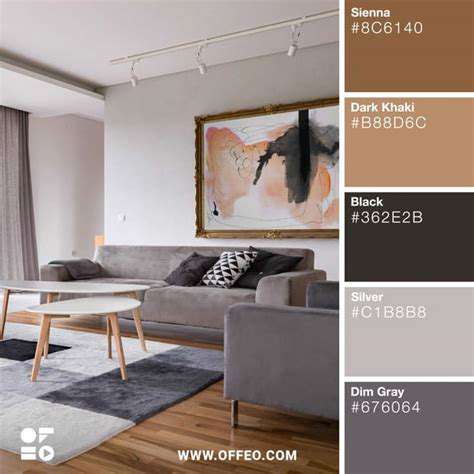
Modern Neutrals
Creating a calming and sophisticated atmosphere, modern neutral palettes rely on a blend of soft greys, warm beiges, and subtle creams. These hues evoke a sense of tranquility and allow other elements of the design, like furniture and artwork, to take center stage. This timeless approach is perfect for those seeking a versatile and enduring aesthetic.
The key to success with modern neutrals lies in the subtle variations and textures used. Avoid stark contrasts and instead focus on creating depth and dimension through nuanced shades and the interplay of different materials. A touch of metallic accents or a patterned rug can add personality without disrupting the overall harmony.
Bold and Vibrant Accents
For those seeking a more dynamic and expressive feel, bold and vibrant accents can transform a space. These palettes embrace strong colors like emerald green, deep blues, or fiery oranges to create a noticeable focal point. The important thing is to use these bold tones strategically, whether it's through a statement piece of furniture, a vibrant throw pillow, or a striking piece of art.
These color choices can create a truly unforgettable and captivating atmosphere. However, it's crucial to balance these bold colors with more neutral or calming tones to prevent the space from feeling overwhelming. Careful consideration of the proportion and placement of the colors is essential for a visually appealing and comfortable result.
Earthy Tones and Natural Elements
Earthy tones, drawing inspiration from nature, are a popular choice for creating a sense of warmth and connection with the outdoors. These palettes often include shades of brown, beige, and greens, echoing the colors of trees, soil, and foliage. The use of natural materials like wood, stone, and woven textiles further enhances this connection to nature.
The incorporation of natural elements creates a sense of serenity and grounding. This approach is ideal for spaces where relaxation and connection to the environment are priorities. Think of a cozy cabin retreat or a calming home office. Incorporating plants can further enhance the natural theme.
Cool and Calming Blues
Cool and calming blues, ranging from serene periwinkle to deep navy, offer a sense of tranquility and sophistication. These colors evoke a sense of peace and calm, making them ideal for bedrooms, meditation spaces, or any area where relaxation is desired. Different shades of blue can be incorporated in various ways, from painted walls to patterned rugs and textiles.
These colors create a space that is both aesthetically pleasing and conducive to relaxation and well-being. The use of varying blue tones can create depth and visual interest, making the room feel both calming and dynamic. Consider integrating soft lighting and natural elements to amplify the calming effect.
Pastel Pastels and Soft Hues
Pastel pastels and soft hues create a lighthearted and airy ambiance, perfect for spaces where a sense of playfulness and joy is desired. These palettes often include shades of lavender, mint green, and peach, which are both visually appealing and soothing to the eye. This approach is particularly well-suited to children's rooms, nurseries, and living spaces that need a touch of vibrancy but without overwhelming intensity.
Pastel palettes offer a refreshing and delicate touch to any room. They are perfect for creating a sense of serenity and calm, without sacrificing a touch of whimsy. The key to success lies in balancing the pastel shades with complementary accents, avoiding overwhelming the space with too many colors.
Harmonizing Colors with Furniture and Accessories: Achieving a Cohesive Look
Choosing the Right Color Palette
Selecting a cohesive color palette is crucial for creating a harmonious space. Consider the existing colors in your room, whether it's a natural wood floor, a patterned rug, or artwork already hung on the walls. A good starting point is to identify the dominant colors and then choose furniture and accessories that complement and enhance them. This allows for a natural flow and avoids jarring contrasts that can make a room feel disjointed. Think about the mood you want to create – warm and inviting, cool and calming, or bold and dramatic – and select colors that align with that desired aesthetic. Careful consideration of the lighting in the room is also important, as different light sources can affect how colors appear.
Don't be afraid to experiment with different shades and tones within a chosen color family. A deep teal sofa can be beautifully complemented by a light teal throw pillow or a mint green accent chair. This subtle variation adds depth and visual interest without overwhelming the space. Understanding color theory and the relationships between different hues can greatly assist in creating a well-balanced and pleasing color scheme that flows seamlessly throughout the room.
Furniture Selection and Placement
The furniture pieces you select play a vital role in achieving a cohesive look. Choosing furniture with colors that complement your chosen palette is essential. If your walls are a soft beige, consider a deep emerald green sofa or a rich mahogany coffee table. These contrasting yet complementary colors create visual interest and balance. The placement of furniture is equally important; strategic arrangement can enhance the flow of the space and the overall harmony of the colors.
Consider the scale and proportion of your furniture in relation to the room size. Oversized furniture in a small space can overwhelm the room, while undersized furniture in a large space might make the room feel empty. Using the right scale of furniture will help you to establish a harmonious and balanced aesthetic. The right furniture placement can help to highlight the focal points of the room and enhance the overall visual appeal.
Accessorizing for Visual Interest
Accessories are the finishing touches that bring a room to life. Strategic use of cushions, throws, rugs, and artwork can significantly impact the overall color harmony. Choose accessories that complement your furniture and wall colors, either by echoing the hues or by providing a contrasting accent. For example, if your sofa is a rich burgundy, consider adding throw pillows in varying shades of burgundy, or a complementary color like cream or gold.
Maintaining Consistency and Balance
Consistency in color throughout the room is key to maintaining a cohesive look. Try to create a visual flow by repeating colors in different elements, such as the rug, curtains, and decorative items. This repetition creates a sense of unity and helps to draw the eye smoothly through the space. Avoid jarring contrasts that can break up the visual flow. A good rule of thumb is to use a maximum of three to five dominant colors in a single space to maintain a sense of balance and harmony.
Balance is another important aspect. Avoid overwhelming a room with too much of any one color. Instead, use a variety of shades and tones to create a well-rounded and visually pleasing space. This will create a balanced and harmonious aesthetic that will complement the furniture and overall color scheme.
Beyond the Basics: Incorporating Textures and Patterns for Depth and Interest

Beyond the Fundamentals of Effective Communication
Effective communication transcends simple clarity; it's a multifaceted skill encompassing active listening, empathy, and the ability to tailor your message to your audience. Understanding your audience's perspective is crucial for crafting a message that resonates and fosters a productive dialogue. Poor communication, on the other hand, can lead to misunderstandings, frustration, and ultimately, negative outcomes. Developing strong communication skills is a continuous journey of learning and refinement.
Communication is not just about transmitting information; it's about fostering understanding and building relationships. This encompasses a wide spectrum of interactions, from formal presentations to casual conversations. The principles of active listening, clear articulation, and respectful dialogue are critical across all these scenarios.
Leveraging Visual Aids for Enhanced Engagement
Visual aids are powerful tools for enhancing audience engagement and comprehension. They can transform complex information into easily digestible formats, making presentations more dynamic and memorable. Using compelling visuals can significantly improve the retention rate of key concepts and messages. Well-designed charts, graphs, and images can significantly improve engagement.
Visual aids serve as a visual reinforcement of the spoken word, allowing the audience to grasp concepts more readily. Thoughtful integration of visuals can turn a potentially dry presentation into a captivating experience.
The Power of Storytelling in Persuasion
Storytelling is a highly effective technique for connecting with audiences on an emotional level. Stories can make complex information more relatable and memorable, helping your message to linger in the minds of your listeners long after the presentation is over. Using real-life anecdotes and examples can significantly amplify the impact of your message. Stories help us make connections and remember details more effectively than simply presenting facts and figures.
By weaving narratives into your presentations, you can build trust, foster empathy, and ultimately, persuade your audience to embrace your viewpoint or take a specific action. Stories allow you to infuse your message with authenticity and human connection.
Mastering Nonverbal Communication Cues
Nonverbal cues, such as body language, facial expressions, and tone of voice, play a significant role in communication. These subtle cues can often convey more information than words alone, influencing how your message is perceived and interpreted. Pay close attention to your nonverbal communication to ensure it aligns with your message and to avoid sending mixed signals.
Understanding and effectively utilizing nonverbal cues can enhance your credibility and persuasiveness. Practicing mindful awareness of your body language, tone, and facial expressions can significantly impact how your message is received.
Building Rapport Through Active Listening
Active listening is paramount to effective communication. It goes beyond simply hearing words; it involves fully concentrating on the speaker, understanding their perspective, and responding thoughtfully. By actively listening, you demonstrate respect and create an atmosphere conducive to open dialogue.
Active listeners show genuine interest in what others have to say. This fosters trust and rapport, leading to more effective interactions and stronger relationships. This skill is crucial for both personal and professional success.
Overcoming Communication Barriers and Obstacles
Effective communication is frequently challenged by various barriers, including cultural differences, language barriers, and differing communication styles. Understanding these potential obstacles is essential for navigating these challenges successfully. Recognizing these nuances allows for proactive strategies to address and mitigate these obstacles.
Developing cultural sensitivity and awareness is crucial for bridging communication gaps and fostering understanding across diverse groups. By acknowledging and addressing potential barriers, you can foster more productive and positive interactions.

